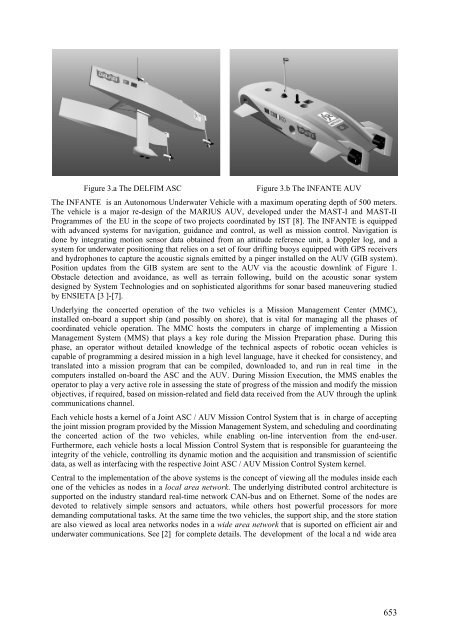EurOCEAN 2000 - Vlaams Instituut voor de Zee
EurOCEAN 2000 - Vlaams Instituut voor de Zee
EurOCEAN 2000 - Vlaams Instituut voor de Zee
You also want an ePaper? Increase the reach of your titles
YUMPU automatically turns print PDFs into web optimized ePapers that Google loves.
Figure 3.a The DELFIM ASC Figure 3.b The INFANTE AUV<br />
The INFANTE is an Autonomous Un<strong>de</strong>rwater Vehicle with a maximum operating <strong>de</strong>pth of 500 meters.<br />
The vehicle is a major re-<strong>de</strong>sign of the MARIUS AUV, <strong>de</strong>veloped un<strong>de</strong>r the MAST-I and MAST-II<br />
Programmes of the EU in the scope of two projects coordinated by IST [8]. The INFANTE is equipped<br />
with advanced systems for navigation, guidance and control, as well as mission control. Navigation is<br />
done by integrating motion sensor data obtained from an attitu<strong>de</strong> reference unit, a Doppler log, and a<br />
system for un<strong>de</strong>rwater positioning that relies on a set of four drifting buoys equipped with GPS receivers<br />
and hydrophones to capture the acoustic signals emitted by a pinger installed on the AUV (GIB system).<br />
Position updates from the GIB system are sent to the AUV via the acoustic downlink of Figure 1.<br />
Obstacle <strong>de</strong>tection and avoidance, as well as terrain following, build on the acoustic sonar system<br />
<strong>de</strong>signed by System Technologies and on sophisticated algorithms for sonar based maneuvering studied<br />
by ENSIETA [3 ]-[7].<br />
Un<strong>de</strong>rlying the concerted operation of the two vehicles is a Mission Management Center (MMC),<br />
installed on-board a support ship (and possibly on shore), that is vital for managing all the phases of<br />
coordinated vehicle operation. The MMC hosts the computers in charge of implementing a Mission<br />
Management System (MMS) that plays a key role during the Mission Preparation phase. During this<br />
phase, an operator without <strong>de</strong>tailed knowledge of the technical aspects of robotic ocean vehicles is<br />
capable of programming a <strong>de</strong>sired mission in a high level language, have it checked for consistency, and<br />
translated into a mission program that can be compiled, downloa<strong>de</strong>d to, and run in real time in the<br />
computers installed on-board the ASC and the AUV. During Mission Execution, the MMS enables the<br />
operator to play a very active role in assessing the state of progress of the mission and modify the mission<br />
objectives, if required, based on mission-related and field data received from the AUV through the uplink<br />
communications channel.<br />
Each vehicle hosts a kernel of a Joint ASC / AUV Mission Control System that is in charge of accepting<br />
the joint mission program provi<strong>de</strong>d by the Mission Management System, and scheduling and coordinating<br />
the concerted action of the two vehicles, while enabling on-line intervention from the end-user.<br />
Furthermore, each vehicle hosts a local Mission Control System that is responsible for guaranteeing the<br />
integrity of the vehicle, controlling its dynamic motion and the acquisition and transmission of scientific<br />
data, as well as interfacing with the respective Joint ASC / AUV Mission Control System kernel.<br />
Central to the implementation of the above systems is the concept of viewing all the modules insi<strong>de</strong> each<br />
one of the vehicles as no<strong>de</strong>s in a local area network. The un<strong>de</strong>rlying distributed control architecture is<br />
supported on the industry standard real-time network CAN-bus and on Ethernet. Some of the no<strong>de</strong>s are<br />
<strong>de</strong>voted to relatively simple sensors and actuators, while others host powerful processors for more<br />
<strong>de</strong>manding computational tasks. At the same time the two vehicles, the support ship, and the store station<br />
are also viewed as local area networks no<strong>de</strong>s in a wi<strong>de</strong> area network that is suported on efficient air and<br />
un<strong>de</strong>rwater communications. See [2] for complete <strong>de</strong>tails. The <strong>de</strong>velopment of the local a nd wi<strong>de</strong> area<br />
653

















